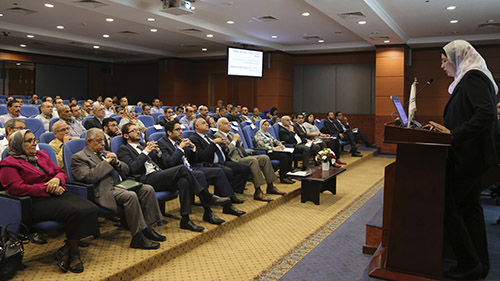On the 21st May, the IEE project held a workshop in close cooperation with the Industrial Development Authority (IDA) to share the results of one of the project’s main activities; providing a broad picture on Energy Efficiency (EE) by benchmarking the energy consumption and usage of three of the most energy intensive industries: Fertilizer, Cement and Iron and Steel.
Careful planning was carried out by IEE; tailoring the UNIDO benchmarking methodology to the Egyptian context. The data collection process was carried out in cooperation with the IDA, which provided UNIDO experts with the national statistics. Then UNIDO experts worked on statistics regarding energy consumption, production levels and practices used for 3 consecutive years from participating plants. These plants were closely involved in the verification of the data to ensure the homogeneity and accuracy of the results. For the first time, there are now reliable and verifiable figures regarding energy consumption in Egypt that can be used in decision and policy making.
These benchmarking reports highlighted each sector’s energy saving potentials. From the three benchmarking reports, the cement sector records the highest potential for energy savings, it can save up to 52 PJ/a while the fertilizer sector comes in the second place saving up to 36.5 PJ/a and finally the iron and steel sector can save up to 11 PJ/a. These savings are based on the scenario where each sector reaches the Best Available Technology (BAT) performance levels by the year 2050.
Benchmarking is not limited to data collection and analysis, but includes the development of benchmarking curves and presents future scenarios, which forecast the potential energy requirements and consumption of these sectors based on EE measures adopted. These forecasts are critical for future policy making and for the formulation of technical support programs, thus setting a foundation for putting industries in the direction of EE.
The industrial sector in Egypt currently consumes about 45% of the national energy consumption. In confronting the energy crisis and climate change, the optimal and efficient use of energy resources is one of the most important areas that requires policy-making by the state and is indeed prioritized in Egypt’s 2030 Sustainable Development Strategy. Priorities are not about increasing the production of energy sources or diversifying energy sources, but are about using energy better; using it in the optimal way. Through efficiency measures, energy intensive industries can save up to 20% of their energy consumption, making it the cheapest energy resource, as there are lots of strategies that can be implemented that do not require big investments.
The benchmarking study is expected to support decision makers when adopting new policies regarding industrial EE, contribute to international competitiveness and play a critical role in the development of sectors road maps towards an improved EE of these three sectors. Only through the combined efforts of policies, decision makers and factory owners can shift Egypt’s energy from critical to efficient.
You can download the three benchmarking reports from the IEE Egypt website: www.ieeegypt.org
